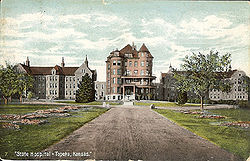Topeka State Hospital
| Topeka State Hospital | |
|---|---|
 | |
| Established | 1875 |
| Construction Began | 1877 |
| Opened | 1879 |
| Closed | 1997 |
| Demolished | 2010 |
| Current Status | Demolished |
| Building Style | Kirkbride Plan |
| Location | Topeka, KS |
| Architecture Style | Queen Anne |
| Peak Patient Population | 1,741 in 1951 |
| Alternate Names |
|
History[edit]
Legislature appropriated $25,000 in 1875 "for the purpose of building an asylum for the insane at some convenient and healthy spot within two miles of the state capitol building in the city of Topeka." One condition was that the land would be acquired at no cost to the state. So the city of Topeka and Shawnee County each contributed $6,000 to purchase the original 80 acres.
The first two ward buildings, accommodating 135 patients, opened in 1872. Dr. Barnard Douglass Eastman resigned as superintendent of the asylum at Worcester MA to become the first superintendent at TSH. The institution was called the Topeka Insane Asylum until 1901 when the Legislature officially changed the name to Topeka State Hospital. Eastman told legislators that patients who were being released to make room for more patients were "well enough to be in a measure useful. All were of a quiet and harmless character."
He described the treatment process this way: "Removal from the worriment, the overwork, the unsanitary conditions and the unsuitable food of many homes ... occupying body and mind in the new employment, cheering the drooping and melancholy and soothing the excited and irritable, are some of the elements of treatment of the greatest value, sometimes working rapid cures with but little medication."
Patients who were able did useful work around the asylum during the day, constructing new buildings, working on the farm or sewing. Patients were admitted to the asylum only by court order. Eastman objected to such demeaning insanity trials, saying "The insane are sick, not criminal." But the policy didn't change until 1919. The Legislature allowed shell-shocked veterans of World War I to be treated at TSH without the indignity of an insanity trial.
An alarm arose in 1948 over the deplorable conditions at TSH, caused by such factors as reduced expenditures by the state and a shortage of psychiatrists, psychologists and other professional personnel. Legal commitment papers couldn't be found for some of the patients, and some patients couldn't even be accurately identified. Many patients still were being admitted as a result of the legal process and weren't having their actual mental conditions evaluated by hospital officials. Patients were sometimes kept chained and nude for months or even years.
Gov. Frank Carlson appointed a five-member panel to study the situation. After the committee released its report in October 1948, the Legislature doubled the appropriations for mental hospitals, made TSH a training center for psychiatric personnel and implemented other changes. The practice of placing patients in rocking chairs in the hallways during the daytime was discontinued. Incidents of patient mistreatment were investigated and corrected. Psychiatrists from the Menninger Foundation volunteered some of their own time to examine patients, and Menninger psychologists helped organize a department of psychology at TSH.
In 1949, the first social worker was hired. She began the first discharge plans for patients who were deemed ready for release. Social workers and volunteers often had to acquaint patients with modern household appliances that didn't exist when they were admitted.
Patients first were able to receive outpatient treatment at TSH in 1951. In subsequent years, the professional staff was increased, including physicians and dentists to treat physical ailments. In 1951, a fully equipped operating room was created. Conditions began to deteriorate again about 1958 because of state funding cutbacks. Staff salaries fell seriously behind salaries offered elsewhere, and experienced staff members were leaving. The good news was that the use of tranquilizing drugs was proving effective on a large percentage of the patients.
By 1968, TSH was back at the leading edge again, at least in terms of how to run a mental hospital. An organization plan, called "The Kansas Plan," was being used as a model for organizing other institutions around the country. It included treatment, research, training and consultation to the communities it served.
But in 1988, the hospital lost its accreditation to receive federal Medicare and Medicaid payments. By the 1990s, the mental health movement was away from the hospital model and toward community-based programs. Partly because the community-based model appeared effective and partly because it was cheaper, the Kansas Legislature decided to close one of its three mental hospitals. TSH was chosen for closing and went out of business May 17, 1997.
On June 1, 2010 demolition began on the center building.
Images of Topeka State Hospital[edit]
Main Image Gallery: Topeka State Hospital
Cemetery[edit]
Although the hospital closed in 1997, a cemetery containing the graves 1,157 remains on the property.
Books[edit]
- On the Avenue of Approach by Barbara Hauschild, 1979.


